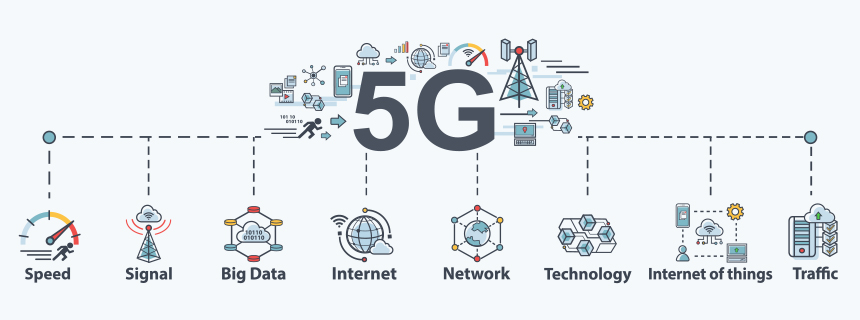Shop At Haya: Your Ultimate Shopping Guide
Discover the best shopping tips, trends, and deals for a smarter buying experience.
Beyond Speed: How 5G is Changing Our Lives
Discover how 5G is revolutionizing our world, powering innovations and transforming everyday life in ways you never imagined!
Understanding 5G: What It Means for Your Daily Life
As we transition into a world increasingly dominated by 5G technology, understanding its impact on our daily lives becomes essential. 5G, the fifth generation of mobile network technology, offers several advantages over its predecessor, 4G. With faster download speeds, lower latency, and the ability to connect more devices simultaneously, 5G has the potential to revolutionize how we communicate, work, and live. Imagine downloading entire movies in seconds or enjoying seamless video calls without interruptions. This leap in technology doesn't just affect smartphones; it extends to smart homes, autonomous vehicles, and the Internet of Things (IoT), creating a more interconnected world.
Moreover, the benefits of 5G can be seen across various sectors, such as healthcare, education, and entertainment. For instance, telemedicine will become more efficient, allowing doctors to conduct remote surgeries with precision thanks to reduced latency. In the realm of education, 5G will facilitate immersive virtual learning experiences that were previously unimaginable. However, with these advancements come challenges, including concerns over privacy and security. As we embrace 5G, it’s crucial to remain informed about these issues and advocate for safe and responsible use of this technology. Understanding 5G is not just about recognizing its capabilities; it's about preparing ourselves for a future that is already unfolding.

The Impact of 5G on Business: Opportunities and Challenges
The advent of 5G technology is revolutionizing the business landscape by offering unprecedented opportunities for efficiency and growth. With significantly faster data speeds and reduced latency, companies can harness 5G to enhance their operations in various ways. For instance, industries such as manufacturing and logistics can implement smart devices and IoT (Internet of Things) solutions, leading to streamlined processes and improved productivity. According to recent reports, businesses leveraging 5G could see a dramatic increase in their operational capabilities, which is expected to propel innovation and create new markets.
However, the transition to 5G technology is not without its challenges. Businesses must navigate the complexities of upgrading their infrastructure, ensuring cybersecurity, and training employees to adapt to these new technologies. Additionally, there is a significant concern regarding the cost of implementation and the potential disparity between urban and rural areas in terms of access to 5G networks. As companies look to capitalize on the benefits of 5G, understanding these challenges will be crucial for sustainable growth in the evolving digital landscape.
5G vs. 4G: What's the Real Difference and Why It Matters
5G and 4G are two generations of mobile network technology that offer distinct capabilities and performance metrics. 4G, officially known as LTE (Long-Term Evolution), has greatly improved internet speed and capacity compared to its predecessor, 3G. It typically offers download speeds of up to 100 Mbps under optimal conditions. In contrast, 5G can provide speeds exceeding 1 Gbps, allowing for ultra-fast downloads, smoother streaming, and better connectivity for multiple devices. This enhanced performance allows industries to innovate, enabling advancements in IoT, smart cities, and autonomous vehicles.
The differences between 5G and 4G extend beyond mere speed. 5G operates on a broader frequency spectrum, tapping into millimeter waves, which facilitates lower latency and improved capacity for data transfer. This means that while 4G has significant lag, resulting in delays that can affect real-time applications, 5G dramatically reduces these delays to 1 millisecond or less. The implications are vast: industries like healthcare can leverage 5G technology for remote surgeries, while gaming can become more immersive and interactive. Understanding these differences empowers consumers and businesses to appreciate the potential of the new technology.